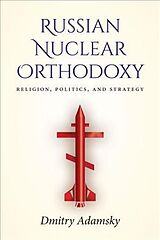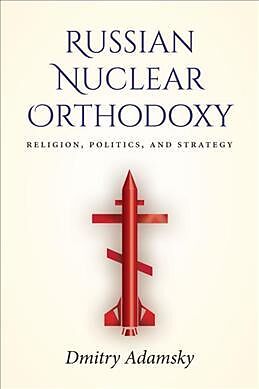Russian Nuclear Orthodoxy
Einband:
Kartonierter Einband
EAN:
9781503608641
Untertitel:
Religion, Politics, and Strategy
Genre:
Politikwissenschaft
Autor:
Adamsky
Herausgeber:
Stanford University Press
Anzahl Seiten:
376
Erscheinungsdatum:
02.04.2019
ISBN:
978-1-5036-0864-1
Informationen zum Autor Dmitry (Dima) Adamsky is Professor in the School of Government, Diplomacy and Strategy at the IDC Herzliya, Israel. Klappentext Dmitry (Dima) Adamsky is Professor in the School of Government! Diplomacy and Strategy at the IDC Herzliya! Israel. Inhaltsverzeichnis Contents and Abstracts1Introduction chapter abstract This chapter introduces the main phenomenon under scrutiny, outlines research objectives, discusses literature lacunae, and introduces the main arguments, the findings, the structure, and the research method of the book. 2State-Church Relations (1991-2000) chapter abstract This chapter deals with the state-church relations. It describes social, cultural, and ideational reasons for the entrance of religion into Russian politics in general and the inception of the church-military cooperation in particular. It describes how during this "genesis decade" the quest for religiosity emerged as a grassroots phenomenon within the nuclear complex and the latter entered into a covenant with the ROC. 3Faith-Nuclear Nexus (1991-2000) chapter abstract This chapter explores the state of the faith-nuclear nexus during the discussed decade. It focuses on the ROC's relations with the nuclear industry, particularly in the closed city of Sarov-the capital of the nuclear weapons complex-and on the first bonds of the Moscow Patriarchate with the corps of the Russian nuclear triad. The chapter describes the introduction of religious ceremonies into the everyday functioning of the nuclear community, the designation of patron saints for nuclear institutions, and the construction of churches in the nuclear weapons industry and in the garrisons of the triad's corps. 4Strategic Mythmaking (1991-2000) chapter abstract This chapter deals with the emergence of strategic mythology-the reading of divine interpretations into the Russian and Soviet military and nuclear history. It describes a search for a new national and professional identity, which marked the exodus of the Russian strategic community, and Russia as a whole, out of the Soviet era. 5State-Church Relations (2000-2010) chapter abstract This chapter deals with the state-church relations during the "conversion decade." It describes how religion began playing an increasing role in Russian politics since the 2000s, and when the leadership began flirting with faith, and when a top-down trend supplemented the initial grassroots impulse. It discusses the ROC's influence on Russian foreign and domestic policy, the public and personal religious persona of President Putin, and the church-military relations and describes how the Kremlin restituted church property, introduced the institution of the military clergy, and enhanced the ROC's role in educational, social, and foreign policies. 6Faith-Nuclear Nexus (2000-2010) chapter abstract This chapter explores the state of the faith-nuclear nexus during the discussed decade. It focuses on the gradual conversion of all the nuclear triad corps and the nuclear weapons industry and describes how the ROC became part and parcel of the nuclear officialdom and catechization and churching peaked in all the services of the nuclear triad by the end of the decade. 7Strategic Mythmaking (2000-2010) chapter abstract This chapter deals with the evolution of the strategic mythology, up to its maturation to the widespread "Russian Nuclear Orthodoxy" concept, arguing that in order to preserve its Orthodox character, Russia needs to ensure its being a strong nuclear power, and to guarantee its nuclear status, it has to be genuinely Orthodox. 8State-Church Relations (2010-2020) chapter abstract This chapter deals with the state-church relations. It describes how the bottom-up and top-down tendencies of the "genesis" and "conversion" decades have merged, reaching a peak of clericalization in state-church relations. It describes how religion has gained extraord...
Autorentext
Dmitry (Dima) Adamsky, Professor at the Lauder School of Government, Diplomacy, and Strategy at Reichman University (IDC Herzliya) in Israel, is the author of Russian Nuclear Orthodoxy (Stanford, 2019) and The Culture of Military Innovation (Stanford, 2010).
Klappentext
Dmitry (Dima) Adamsky is Professor in the School of Government, Diplomacy and Strategy at the IDC Herzliya, Israel.
Inhalt
1. Introduction
2. State-Church Relations (1991-2000)
3. Faith-Nuclear Nexus (1991-2000)
4. Strategic Mythmaking (1991-2000)
5. State-Church Relations (2000-2010)
6. Faith-Nuclear Nexus (2000-2010)
7. Strategic Mythmaking (2000-2010)
8. State-Church Relations (2010-2020)
9. Faith-Nuclear Nexus (2010-2020)
10. Strategic Mythmaking (2010-2020)
11. Conclusion
12. Epilogue

Leider konnten wir für diesen Artikel keine Preise ermitteln ...
billigbuch.ch sucht jetzt für Sie die besten Angebote ...
Die aktuellen Verkaufspreise von 6 Onlineshops werden in Realtime abgefragt.
Sie können das gewünschte Produkt anschliessend direkt beim Anbieter Ihrer Wahl bestellen.
Loading...
Die aktuellen Verkaufspreise von 6 Onlineshops werden in Realtime abgefragt.
Sie können das gewünschte Produkt anschliessend direkt beim Anbieter Ihrer Wahl bestellen.
| # | Onlineshop | Preis CHF | Versand CHF | Total CHF | ||
|---|---|---|---|---|---|---|
| 1 | Seller | 0.00 | 0.00 | 0.00 |
